Judi Lynn
Judi Lynn's JournalThe Aftermath Of 2019 Bolivian Coup - OpEd
June 9, 2020 Yanis Iqbal 0 Comments
By Yanis Iqbal

Bolivia's Evo Morales
Ever since the racist right-wing government of Jeanine Anez has assumed power, Bolivia is continuously experiencing politico-economic tumult. Recently, seven legislators of the Movement towards Socialism (MAS) filed a complaint against the Ministers of Government and Defense, Arturo Murillo and Luis Fernando López, for misconduct in the purchase of riot gear equipments. As per the complaint, the post-coup Bolivian government unfavorably cancelled its purchase with the Brazilian corporation Condor. Thereafter, the Bolivian government signed an agreement with an American company named Bravo Tactical Solutions. The Shifting of purchase to Bravo Tactical Solution has allegedly cost the Bolivian government a surcharge of $2 million. This recent incident of dishonest dealing is one among the 35 cases of corruption which have occurred since Evo Morales, the radical Aymara socialist president of Bolivia, was illegally overthrown with the help of US support. Prominent among these cases was the ventilator scandal in which the governmental coup-plotters purchased 170 unusable ventilators worth $1.2 million for $4.7 million. Due to the public outrage which this corruption scandal generated, the health minister Marcelo Navajas had to be suspended.
The increasing numbers of corruption scandals are highlighting a fundamental feature of the new post-coup government: the new government does not care for the well-being of the Bolivian populace. The historical conditions in which it emerged shaped it as an authoritarian administration which had to act as the handmaiden of US imperialism and neoliberalism. To better understand these structural features of the post-coup government which are going to play out importantly in the future, we need to examine the circumstances in which it rose to power.
In November 2019, the democratically elected socialist president of Evo Morales was ousted through a US-orchestrated coup. This coup was initially spawned by the Organization of American States (OSA) which published a report falsely claiming that the 2019 Bolivian elections were rigged. In the report, OAS expressed “its deep concern and surprise at the drastic and hard-to-explain change in the trend of the preliminary results revealed after the closing of the polls”. Despite being “long on accusations and short on facts”, this report was uncritically absorbed and iterated by major publishing outlets without any qualms. Later on, OAS’s audacious prevarications were disproved by MIT in an article published by Washington Post in which it said that “As specialists in election integrity, we find that the statistical evidence does not support the claim of fraud in Bolivia’s October election”. Moreover, an independent verification carried out by The Center for Economic and Policy Research also found that there wasn’t any “quantitative evidence of an irregular trend as claimed by the OAS”.
In spite of subsequent refutations, OAS had already done much damage through its strategically organized falsification campaign. Using the utterly spurious OAS report on October elections, the far-right of Bolivia started to conflagrate the political environment. On November 4 2019, Luis Fernando Camacho, a multi-millionaire businessman from separatist Santa Cruz, promised to “bring the Bible back to the palace of government”. Furthermore, he told Morales to resign within 24 hours and pompously said to a crowd of supporters: “I’m not going with weapons, I’m going with my faith and my hope; with a Bible in my right hand and a resignation letter [for Morales] in my left hand.” Camacho somehow managed to enter the main hall of the presidential palace and placed the bible on a Bolivian flag. After the turmoil of Bolivian coup had settled, Fernando Camacho met Luis Almagro, head of the OAS, in Washington DC who praised Camacho’s “commitment to democracy”. In addition, Camacho was also a guest speaker at the Inter-American Dialogue, a Washington DC-based think tank, whose shadowy aim is to “foster democratic governance, prosperity, and social equity in Latin America and the Caribbean”.
The symbolic act of placing the bible on a Bolivian flag defines the core anti-indigenist ideology of Fernando Camacho. This ideology wants to relegate the indigenous people to a position of secondary citizens and aspires to ruthlessly subjugate them. The burning of Wiphala flags by Camacho’s supporters highlights the hatred for a plurinational state which is not coerced by Catholicism into mistreating the 36 indigenous groups of Bolivia. But despite its toxic features, the coup plotters garnered backing from USA which, through its conspicuous silence, gave tacit consent to the ongoing violence. Right-wing gangs ransacked the home of Evo Morales, assaulted MAS officials and publicly tortured a female socialist mayor. The final blow came with the November 8-10, 2019 mutinies of the military and police when top Army General Williams Kaliman asked Morales to leave. It is pertinent to remember that Williams Kaliman was trained at the School of Americas which, through its engagement in the dirty wars of Argentina, Chile, Colombia, Guatemala, Peru, El Salvador, Ecuador, Honduras, Panama and Nicaragua, has acquired a variety of names such as School of Assassins, School of Coups and School of Dictators.
More:
https://www.eurasiareview.com/09062020-the-aftermath-of-2019-bolivian-coup-oped/
Journalists who revealed evidence of plot to rig Colombia's 2018 election send out SOS
by Adriaan Alsema June 9, 2020
The journalists who revealed evidence Colombia’s ruling party plotted with the mafia to rig the 2018 elections in favor of President Ivan Duque sent out an SOS on Monday.
The four journalists said in a statement that presidential aides and prosecution officials warned them that “attempts on our lives, our freedom and our honor are being prepared” by state authorities.
The journalists said they are in danger “for having uncovered that drug money had been used in the buying of votes and the illicit financing of the campaign of the current president, Ivan Duque.”
The journalists who revealed the 2018 election rigging plot

Gonzalo Guillen
Gonzalo Guillen is one of Colombia’s most senior and renowned journalists and the founder of national news agency Colprensa. The journalist has won several international awards for his work and is currently the editor-in-chief of news website La Nueva Prensa.
More:

Colombia arrests cops who discovered 2018 election fraud plot
by Adriaan Alsema June 7, 2020
Colombia’s prosecution arrested the policemen who accidentally discovered a 2018 election rigging plot between the far-right party of President Ivan Duque and drug traffickers.
The arrest of Major Yefferson Tocarruncho and Sergeant Wadith Velasquez went almost unnoticed because chief prosecutor Francisco Barbosa caused a political hurricane by ordering the arrest of Antioquia Governor Anibal Gaviria on vague corruption charges.

Former President Alvaro Uribe (L) and late mafia associate
Luis Guillermo Hernandez. (Image: Instagram)
Not the suspects, but the investigators in jail
Ironically, the investigators who discovered the election fraud scandal are now in jail while those suspected of plotting to rig the 2018 elections are free, with the exception of Jose Guillermo Hernandez, a.k.a. “El Ñeñe,” who was murdered in Brazil in May last year.
Bogota Mayor Claudia Lopez accused the prosecution of purposely trying to divert the attention away from the election fraud scandal known in Colombia as “Ñeñepolitics.”
More:
https://colombiareports.com/colombia-arrests-cops-who-discovered-2018-election-fraud-plot/
George Floyd's Autopsy and the Structural Gaslighting of America
The weaponization of medical language emboldened white supremacy with the authority of the white coat. How will we stop it from happening again?
By Ann Crawford-Roberts, Sonya Shadravan, Jennifer Tsai, Nicolás E. Barceló, Allie Gips, Michael Mensah, Nichole Roxas, Alina Kung, Anna Darby, Naya Misa, Isabella Morton, Alice Shen on June 6, 2020
The world was gaslit by misreporting about George Floyd’s initial autopsy report. As concerned physicians, we write to deconstruct the misinformation and condemn the ways this weaponization of medical language reinforced white supremacy at the torment of Black Americans.
Gaslighting is a method of psychological manipulation employed to make a victim question their own sanity, particularly in scenarios where they are mistreated. The term comes from a 1938 play and, later, a popular film, wherein a predatory husband abuses his wife in a plot to have her committed to a mental institution. He dims the gas lights in their home; then, when she comments on the darkness, knowingly rejects her observation and uses it as evidence that she’s gone insane. It’s a torturous tactic employed to destroy a person’s trust in their own perception of reality. It’s a devastating distraction from oppression. It’s insidious. And it happened recently when millions of people who had seen nine agonizing minutes of murder were told by an autopsy report that they hadn’t.
In America, widespread anti-Black violence is often paired with structural gaslighting. Racism, after all, thrives when blame for its outcomes are misattributed. When Black families are refused loans in criminally discriminatory housing schemes, their credit is blamed. When youth of color are disproportionately stopped and frisked, they are told the process is random, and for their safety.
And when Black people are killed by police, their character and even their anatomy is turned into justification for their killer’s exoneration. It’s a well-honed tactic. One analysis of the national database of state-level death certificate data found that fewer than half of law enforcement–related deaths were reported. In addition to this undercounting, police actions were further minimized by the use of diagnostic codes that incorrectly labeled the cause of death as “accidental” or “undetermined” rather than police-related. For centuries, our systems have relied on this psychological torture—a host of mental gymnastics—to deny the truth of what Black people have always known. The cause of death is racism.
More:
https://blogs.scientificamerican.com/voices/george-floyds-autopsy-and-the-structural-gaslighting-of-america/
Despite history, Japanese Americans and African Americans are working together to claim their rights
Densho
February 23, 2016 · 8:30 AM EST
By Natasha Varner
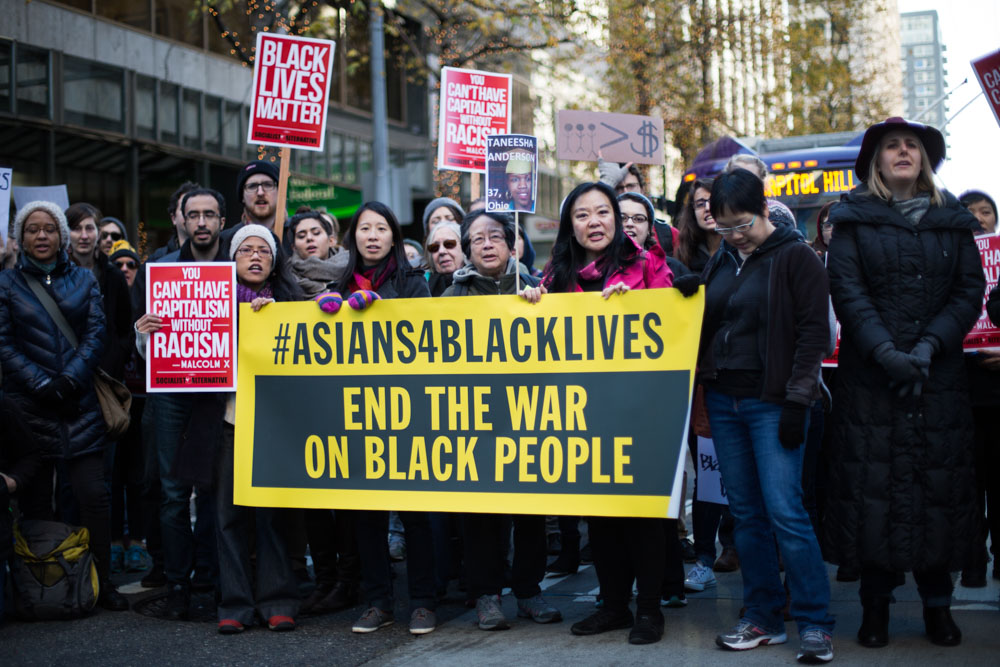
#Asians4BlackLives at a Seattle protest in support of Black Lives Matter in November.
Credit:
Jama Abdirahman/The Seattle Globalist
During World War II, the fates of Blacks and Japanese Americans crossed in ways that neither group could have anticipated.
While Japanese Americans were being forced to abandon the lives they'd built on the West Coast, African Americans were in the midst of the Great Migration out of the South. During the war, many Black migrants set their sites on the West Coast, where labor shortages in the defense industry brought new employment opportunities. Vacated Japanese American neighborhoods provided space for these new arrivals to establish themselves, but the process of putting down roots did not come easy.
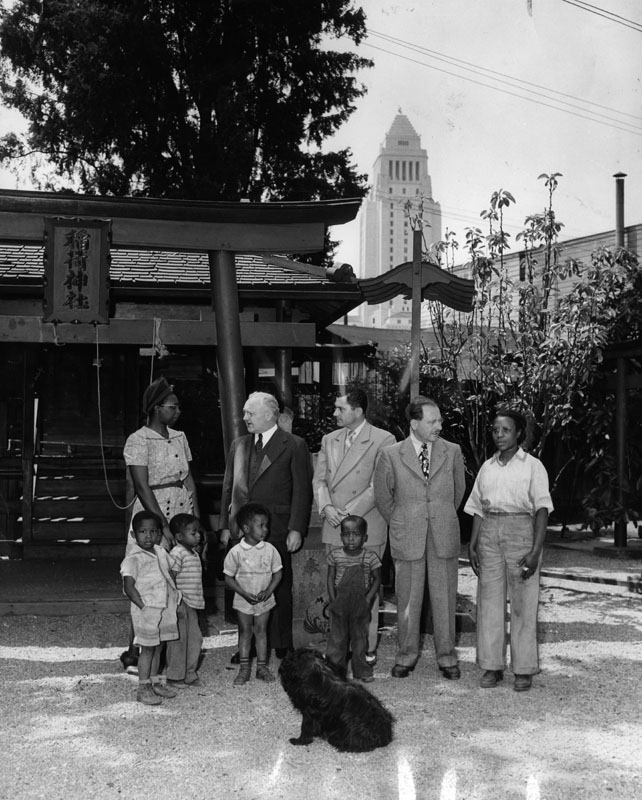
In May, 1944, an abandoned Shinto shrine in newly formed Bronzeville. This is the Los Angeles neighborhood, Little Tokyo, where African Americans laborers were housed during Japanese American internment. Shown with Mayor Fletcher Bowron are a Bronzeville family (unnamed by the source), Dr. George M. Uhl, city health officer, and Nicola Giulli, chairman of the City Housing Authority.
Credit:
Otto Rothschild/Los Angeles Public Library Photo Collection
Take Los Angeles, for example. While Black laborers were welcomed in the city‘s defense industries, the lives and families they brought with them were not. Restrictive housing covenants barred people of color from living in white neighborhoods, so the newly vacated Japanese American neighborhood known as Little Tokyo was one of the few places that had space available to arriving African Americans.
About 80,000 people — most of them African American — took up residence in an area that had been home to approximately 30,000 Japanese Americans before the war. Little Tokyo was rechristened Bronzeville and Black-owned businesses replaced shuttered Japanese Americans establishments. The deserted Kawafuku restaurant reopened as Shepp's Playhouse, one of many night clubs that hosted the likes of Coleman Hawkins, T-Bone Walker and Herb Jeffries from the Duke Ellington band.
As the Black community began to thrive, overcrowding and governmental neglect led to an increase in crime and public health concerns in Bronzeville. The neighborhood was treated as a blight by the city of Los Angeles, with officials regularly issuing evictions and abatement notices in response to living conditions they deemed substandard. This was the cruel irony of the structural racism Black residents faced in wartime Los Angeles: They were punished for the inevitable outcomes of overcrowding that the city‘s restrictive housing covenants had caused.
Even as African Americans were struggling for their own basic rights in Los Angeles, individual stories document an incredible showing of support for incarcerated Japanese Americans. Takashi Hoshizaki, for example, recalled the shock and joy he felt at discovering his Black neighbors, the Marshalls, had traveled all the way to the Pomona detention facility in order to bring apple pie and ice cream to his family. Boyle Heights resident Mollie Wilson had a number of Japanese American friends in pre-War Los Angeles. Throughout their incarceration, she kept in regular contact with several of them, sending morale-boosting letters, cards, pictures and gifts.
More:
https://www.pri.org/stories/2016-02-23/despite-their-history-japanese-americans-and-african-americans-are-working
WOLA: Media's 'Left' Source for Pro-Coup Propaganda in Venezuela
JUNE 4, 2020
LUCAS KOERNER

The mass media, as Noam Chomsky and Edward Herman documented decades ago, are structurally dependent on pre-ordained “experts,” who play a decisive role in filtering the information reaching the public.
When it comes to Venezuela, one DC-based think tank has become the Western media’s go-to source for confirming the US elite’s regime change groupthink (FAIR.org, 4/30/19): the Washington Office on Latin America (WOLA).
Styling itself the “leading source for independent analysis and commentary on Latin America,” WOLA is regularly cited in corporate media reporting on Venezuela across the media spectrum. Founded in 1974 and originally part of the progressive Central American solidarity movement, WOLA moved to the right in the 1990s, until by 2002 it was calling (12/02) for a “negotiated and peaceful settlement” to the “political impasse” in Venezuela, where Hugo Chavez had been reelected with 60% of the vote two years earlier. But WOLA’s “progressive” reputation—based on its decades-old critiques of Reagan administration Central America policy—still allows it to position itself as the gatekeeper of legitimate “opposition” to US Latin America policy.
WOLA’s in-house Venezuela “experts”—Tulane University sociologist David Smilde and former Open Society Latin Americanist Geoff Ramsey—excel at disseminating polite, proceduralist criticisms of US policy while validating the imperial assumptions that justify Washington’s aggression. They demarcate the leftmost extreme of acceptable opinion on Venezuela, effectively boxing out any genuinely dissenting views.
More:
https://fair.org/home/wola-medias-left-source-for-pro-coup-propaganda-in-venezuela/?utm_source=rss&utm_medium=rss&utm_campaign=wola-medias-left-source-for-pro-coup-propaganda-in-venezuela
Lost Monument of Early Maya Civilisation Discovered in Mexico

By George Dvorsky on 03 Jun 2020 at 11:30AM
The surprising discovery of a 2,800-year-old monumental structure in Tabasco, Mexico, is shaking our conceptions of Maya civilisation and its emergence as a cultural force.
Using a technology called lidar, in which lasers are used to map hidden surface features from above, archaeologists discovered a previously unknown monumental structure at the Aguada Fénix site in Mexico. This artificial platform – presumably used for naked-eye astronomy – is now the earliest and largest ceremonial structure belonging to the Maya civilisation. Details of this remarkable discovery were published today in Nature.
The platform and its supporting structures, including reservoirs, causeways, and a pyramid-like mound, were found in the Maya lowlands and radiocarbon dated to between 3,000 and 2,800 years ago. It’s conventionally believed that the development of Maya civilisation was a slow and gradual process, with small villages emerging between 2,000 and 1,650 years ago. That such a large and sophisticated ceremonial complex appeared so long ago comes as a big surprise, and its early presence is challenging traditional notions of when Maya civilisation began to emerge.
Indeed, there’s much to learn about the Maya, as much of their legacy remains hidden beneath a huge blanket of trees. Two years ago, for example, a comprehensive aerial survey uncovered 61,480 distinct ancient Maya structures in the lush rainforests of Guatemala. Lidar has led to similar discoveries at Angkor Wat in Cambodia, in which the jungle-penetrating laser uncovered a hidden early capital of the Khmer Empire.
More:
https://www.gizmodo.co.uk/2020/06/lost-monument-of-early-maya-civilisation-discovered-in-mexico/
US Again Complicit in an Illegal Coup, This Time in Bolivia
US Again Complicit in an Illegal Coup, This Time in Bolivia
December 3, 2019
Washington is upholding a sordid tradition of meddling in the political and economic affairs of Latin American countries, writes Marjorie Cohn.
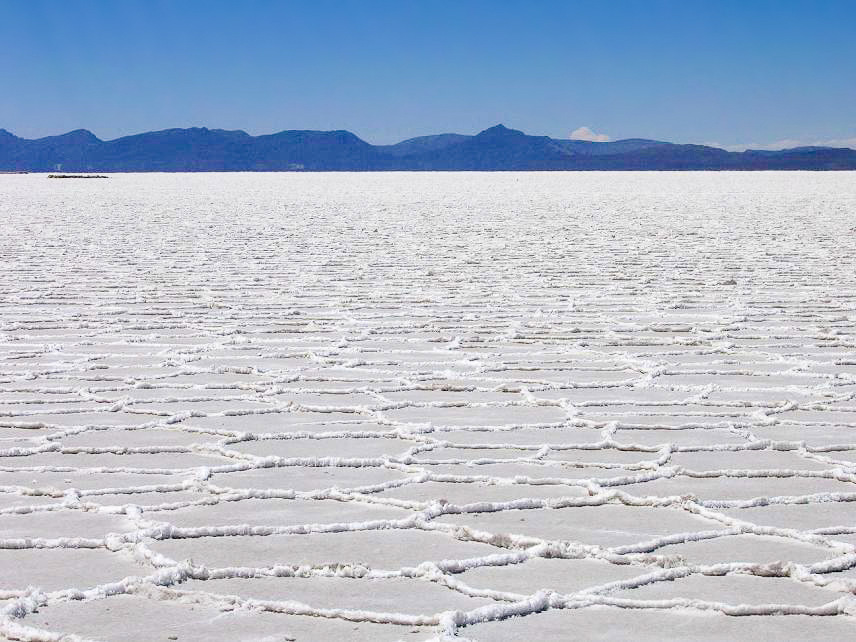
Bolivia’s Salar de Uyuni (or Salar de Tunupa) is the world’s largest salt flat and it covers a pool of brine, which is exceptionally rich in lithium. (Anouchka Unel /Wikimedia Commons)
By Marjorie Cohn
Truthout
Once again, the United States is complicit in an illegal coup d’état in Latin America, this time in Bolivia. On Nov. 10, a right-wing, anti-indigenous group seized power after the Bolivian military’s removal of President Evo Morales, who had declared victory in the Oct. 20 presidential election.
The United States’ fingerprints are all over the coup. Advisers from the U.S. Southern Command have been stationed on Bolivia’s border with Argentina, Ivanka Trump made a surprising visit to an Argentine province near the Bolivian border in September, the pro-U.S. Organization of American States (OAS) cast unfounded doubt on Morales’s election victory, and the U.S.’s National Endowment for Democracy provided suspicious grants to Bolivia.
At least 32 people have been killed and hundreds injured since the coup began. Sacha Llorenti, Bolivian ambassador to the United Nations, told Democracy Now!, “We are going through not just a coup d’état, but a violent one.” Indeed, it has resulted in “the rise of a far-right regime of terror,” professor Gabriel Hetland wrote in The Washington Post.
Morales — Bolivia’s first indigenous leader in a country where 65 percent of the people are indigenous — received 10 percent more votes than Carlos Mesa, the second-place candidate who has close ties to the U.S. government. Mesa was in regular communication with U.S. officials who were trying to destabilize Morales, U.S. government cables published by WikiLeaks reveal.
. . .
The Nov. 10 military coup led to the forced resignation of Morales, who received asylum in Mexico. Right-wing politician Jeanine Añez declared herself interim president, and Donald Trump immediately recognized her illegitimate claim to the presidency. Añez then issued a decree immunizing the military from criminal liability “for carrying out necessary actions in their legitimate defense while performing their constitutional duties.” Morales supporters accused Añez of giving soldiers “carte blanche” to shoot demonstrators. Bolivia’s human rights ombudsman and reporters have documented widespread injuries and fatalities from gunshots.
More:
https://consortiumnews.com/2019/12/03/us-again-complicit-in-an-illegal-coup-this-time-in-bolivia/
Macri and the US Involvement in the Bolivian Coup Starting to Emerge
20/11 – Macri and the US Involvement in the Bolivian Coup Starting to Emerge
20 november, 2019
Text från Resumen Latinamericano.
By Stella Calloni on November 18, 2019
On November 18, which is a holiday in Argentina, thousands of people occupied the Plaza de Mayo in Buenos Aires against the coup d’état in Bolivia and in solidarity with the Chilean people, paying tribute to the victims and the resistance of the people, while evidence and condemnation continue to emerge about the complicity of the government of Mauricio Macri, and especially of the governor of Jujuy, Gerardo Morales with the coup plotters and with the U.S. officials who support and direct them.

Ivanka Trump in Jujuy, Photo: Kevin Lamarque
Macri, his followers and the media in line with Washington continue to maintain that there is no coup d’état in Bolivia, an attitude that was rejected by the demonstrators in the communiqué they read, signed by social, political, humanitarian and Bolivian organizations and Chileans residing in Buenos Aires.
The complicity of Morales is becoming more evident every day as documentation from Bolivia, as well as from Argentine and Brazilian investigators, are exposing the connection which also accuses Brazilian President Jair Bolsonaro of being in on the collaboration.
According to new revelations, Mauricio Macri’s government knew about Luis Fernando Camacho’s coup decision six days in advance. The report refers to a meeting that the right-wing businessman had with diplomatic representatives of the consulates of other countries located in Santa Cruz de la Sierra on November 4, as the well-informed website “The Rocket to the Moon” directed by journalist Horacio Verbistky points out.
More:
https://efolket.eu/kosmopolitiskt/macri-and-the-us-involvement-in-the-bolivian-coup-starting-to-emerge/
This article delivers so much information to research. So much new information it's amazing. Much of it has surfaced briefly from time to time, but not with context. Hoping so hard I can find more in English on every bit of it. The source is Swedish.
It was NEVER mentioined Ivanka actually went to Jujuy, although we did hear rumors long ago when George W. Bush's daughter, Jenna, went to Paraguay.
Who killed Berta Cáceres? Behind the brutal murder of an environment crusader
Could there ever be justice for someone like Berta in a country like Honduras, where impunity reigns supreme?
Nina Lakhani
Tue 2 Jun 2020 00.00 EDT
The final few months of Berta Cáceres’s life were filled with ominous signs. Just before Christmas 2015, she confided in her sister Agustina that her life was in danger. “The messages never stop, the harassment never stops, they have me under surveillance. They don’t care that I have children. Those sons of bitches are going to kill me.”
Berta was involved in numerous land and water struggles alongside indigenous Lenca communities across western Honduras. But the battle to stop construction of a hydroelectric dam on the Gualcarque river, in the community of Río Blanco, had her more worried than usual. Berta told her children she was scared, and that they should take the threats seriously. “Mum said there was a group of dangerous sicarios [hitmen] attacking the Río Blanco community and asking about us, her daughters,” said Laura, 23, the youngest, home from midwifery college for the Christmas break. “I knew the threats were serious because she wouldn’t leave me alone in the house, not even for a night.”
Berta had reasons to suspect the hitmen were hired by Desa, the dam construction company. Desa’s trumped-up criminal charges against her and other leaders of the Council of Popular and Indigenous Organizations of Honduras (Copinh) had failed to silence them. Was it now it was pursuing other means to stop the opposition?
Her sense of unease intensified on 12 February 2016. Douglas Bustillo, a thuggish former army lieutenant and Desa’s ex-security chief, messaged her Copinh deputy, Tomás Gómez, out of the blue, accusing Berta of cashing in on the Río Blanco struggle to win the prestigious Goldman environmental prize.
More:
https://www.theguardian.com/world/2020/jun/02/who-killed-berta-caceres-behind-the-brutal-of-an-environment-crusader




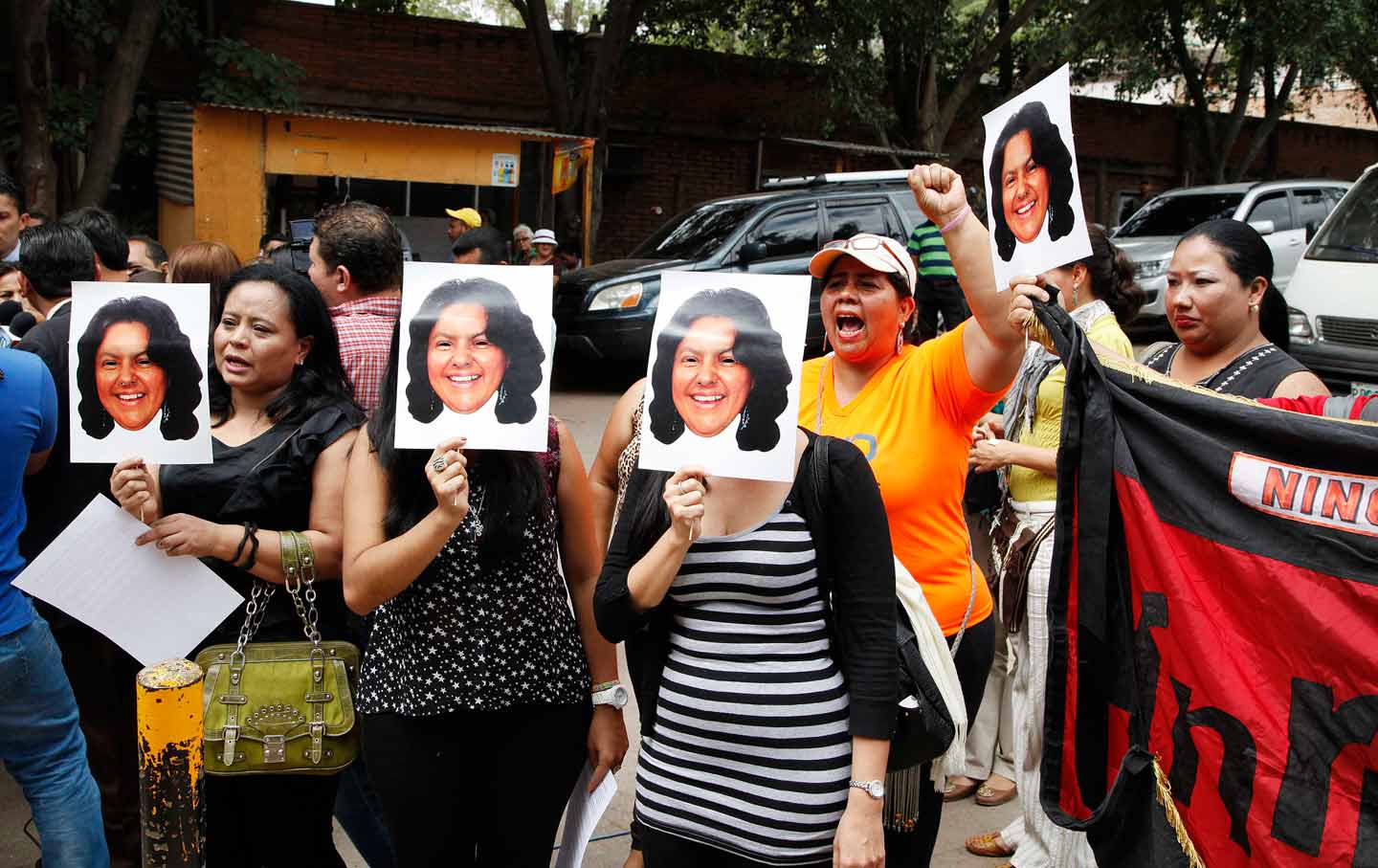
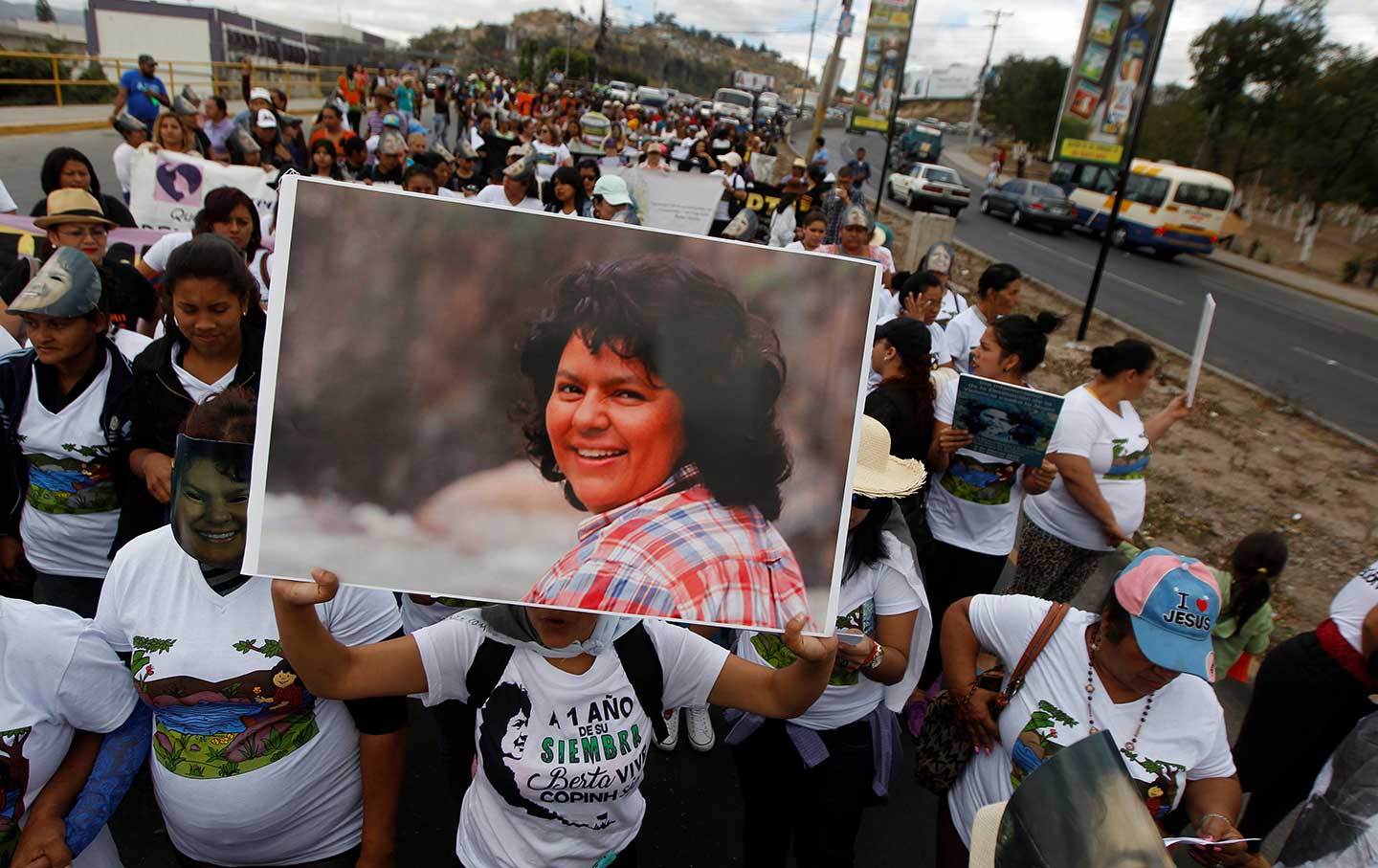

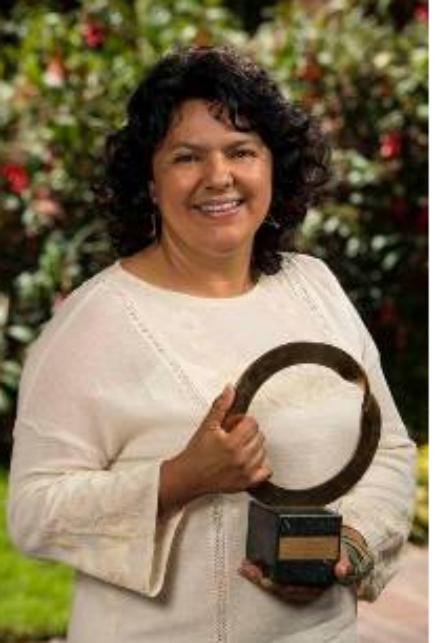
Rest in Peace, Berta Cáceres.
Profile Information
Member since: 2002Number of posts: 160,516